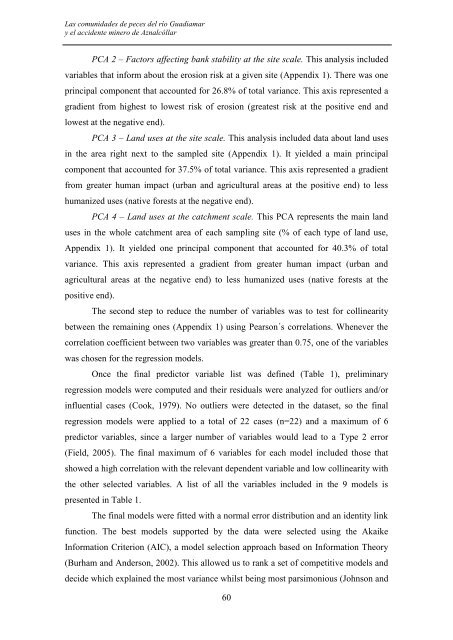las comunidades de peces del río guadiamar y el accidente minero ...
las comunidades de peces del río guadiamar y el accidente minero ...
las comunidades de peces del río guadiamar y el accidente minero ...
You also want an ePaper? Increase the reach of your titles
YUMPU automatically turns print PDFs into web optimized ePapers that Google loves.
Las <strong>comunida<strong>de</strong>s</strong> <strong>de</strong> <strong>peces</strong> <strong>de</strong>l <strong>río</strong> Guadiamar<br />
y <strong>el</strong> acci<strong>de</strong>nte <strong>minero</strong> <strong>de</strong> Aznalcóllar<br />
PCA 2 – Factors affecting bank stability at the site scale. This analysis inclu<strong>de</strong>d<br />
variables that inform about the erosion risk at a given site (Appendix 1). There was one<br />
principal component that accounted for 26.8% of total variance. This axis represented a<br />
gradient from highest to lowest risk of erosion (greatest risk at the positive end and<br />
lowest at the negative end).<br />
PCA 3 – Land uses at the site scale. This analysis inclu<strong>de</strong>d data about land uses<br />
in the area right next to the sampled site (Appendix 1). It yi<strong>el</strong><strong>de</strong>d a main principal<br />
component that accounted for 37.5% of total variance. This axis represented a gradient<br />
from greater human impact (urban and agricultural areas at the positive end) to less<br />
humanized uses (native forests at the negative end).<br />
PCA 4 – Land uses at the catchment scale. This PCA represents the main land<br />
uses in the whole catchment area of each sampling site (% of each type of land use,<br />
Appendix 1). It yi<strong>el</strong><strong>de</strong>d one principal component that accounted for 40.3% of total<br />
variance. This axis represented a gradient from greater human impact (urban and<br />
agricultural areas at the negative end) to less humanized uses (native forests at the<br />
positive end).<br />
The second step to reduce the number of variables was to test for collinearity<br />
between the remaining ones (Appendix 1) using Pearson´s corr<strong>el</strong>ations. Whenever the<br />
corr<strong>el</strong>ation coefficient between two variables was greater than 0.75, one of the variables<br />
was chosen for the regression mo<strong>de</strong>ls.<br />
Once the final predictor variable list was <strong>de</strong>fined (Table 1), pr<strong>el</strong>iminary<br />
regression mo<strong>de</strong>ls were computed and their residuals were analyzed for outliers and/or<br />
influential cases (Cook, 1979). No outliers were <strong>de</strong>tected in the dataset, so the final<br />
regression mo<strong>de</strong>ls were applied to a total of 22 cases (n=22) and a maximum of 6<br />
predictor variables, since a larger number of variables would lead to a Type 2 error<br />
(Fi<strong>el</strong>d, 2005). The final maximum of 6 variables for each mo<strong>de</strong>l inclu<strong>de</strong>d those that<br />
showed a high corr<strong>el</strong>ation with the r<strong>el</strong>evant <strong>de</strong>pen<strong>de</strong>nt variable and low collinearity with<br />
the other s<strong>el</strong>ected variables. A list of all the variables inclu<strong>de</strong>d in the 9 mo<strong>de</strong>ls is<br />
presented in Table 1.<br />
The final mo<strong>de</strong>ls were fitted with a normal error distribution and an i<strong>de</strong>ntity link<br />
function. The best mo<strong>de</strong>ls supported by the data were s<strong>el</strong>ected using the Akaike<br />
Information Criterion (AIC), a mo<strong>de</strong>l s<strong>el</strong>ection approach based on Information Theory<br />
(Burham and An<strong>de</strong>rson, 2002). This allowed us to rank a set of competitive mo<strong>de</strong>ls and<br />
<strong>de</strong>ci<strong>de</strong> which explained the most variance whilst being most parsimonious (Johnson and<br />
60

















